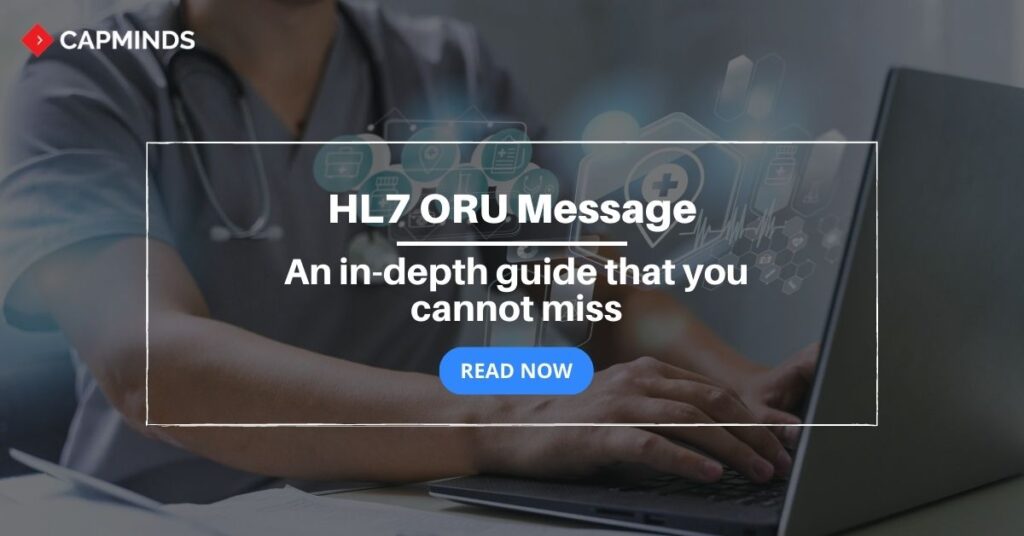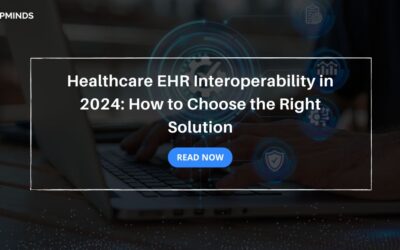HL7 ORU Message: An in-depth guide that you cannot miss
HL7 messages act as a medium and work as consolidated sources of information to create a secured mechanism for exchanging sensitive health data which is vulnerable to hacking.
As we speak now, more than 92% of the US health institutes use HL7, and its widespread adoption in a minimum of 27 countries made it a global standard. HL7 message overall has many examples but the ORU message is a supreme and uppermost method of sharing information.
This article covers the following contents;
- What Is HL7 ORU Message?
- What Are The Types Of HL7 ORU Messages?
- What Is The Structure Of An ORU Message?
- What Are The Contents Of An HL7 ORU Message?
- How Can You Create An HL7 ORU Message?
- How Can You Send An HL7 ORU Message?
- What Are The Different Fields In An HL7 ORU Message?
- HL7 Services From CapMinds
What Is HL7 ORU Message?
- HL7 ORU (Observation Result) is a type of HL7 Message for exchanging observational clinical, lab, or other test results with different systems.
- It contains patients’ medical observation information.
- It is a response made to the order received from a clinical system.
- The message that is ordered is called HL7 Order Entry or ORM message.
- An ORU message is developed to lodge information sharing in EKG & imaging studies and labs.
- It helps transmit order and results related to clinical trials like drug development.
- Each ORU message contains many segments that facilitate you to build any clinical report as a multiple-level ladder and form a complete message.
RELATED: HL7 Messages: An Inside-Out Analysis Guide
What Are The Types Of HL7 ORU Messages?
HL7 ORU message has two types
1. ORU^R01 HL& Message
- This type is an unsought transfer of data between two systems. From the result-producing to the ordering system.
- This encounter happens without receiving an order from the other system.
- It helps to exchange results from a producing system like the EKG system or LIS to a medical record archival system like HIS or EMR for registering for clinical trials or sharing medical reporting.
- HL7 ORU R01 message covers many types of observations like;
- EKG pulmonary function study results
- Imaging study reports
- Patient condition data or other health data like allergies, vital signs, etc.
- Laboratory results
2. ORU^W01 HL7 Message
- It is an unsought ORU message or a waveform response (data generated from electrocardiograms) that exchanges requested data.
- Simply put, the system receives the order and transfers data.
- The information is the result of an ordered series of tests or observations.
What Is The Structure Of An ORU Message?
- ORU message is a class-conscious or hierarchical structure connected with a trigger event or an encounter.
- HL7 explains a trigger event as “an event in the real world of health care (that) creates the need for data to flow among systems.”
- Whenever a trigger event happens like a patient admission or discharge, it contains a connected abstract message that describes the type of data providers are required to share in response to the event.
- The abstract message is a set of segments.
What Are The Contents Of An HL7 ORU Message?
The HL7 ORU message format merges codes, numbers, and texts that communicate results. It includes segments that mention sections with specific portions of information that combine to form the overall message. Some segments are mandatory and others are optional in this message.
[ ] – specifies optional segments.
{ } – refers repetition.
PID (Patient Identification)
- This includes patient-centered information like names, date of birth, patient identifier, etc.
- The message must relate to and contain information about that particular patient as it is patient-centered.
- This segment is mandatory.
MSH (Message Heading)
- This segment is very vital because it has information on the receiver & sender and the date & time of the message generation.
OBR (Observation Request)
- This crucial segment assists in identifying the observation received in OMR to create an ORU message.
PV1 (Patient Visit)
- This is a required section and involves details of patient visits like servicing facility, attending physician, and visit ID.
[{CTI}] Clinical Trial Identification
- This is an optional segment and emerges if the results connect to a clinical trial.
- Includes information like the trial time point, ID, and the study phase.
- If there are various clinical trial identifications, this can occur once or repeats in the same message.
[{OBX}] Observation Segment
- This segment contains information about the observation result.
- This one communicates just one observation.
- This segment would repeat for observations more than one.
- This section is an optional one and repeats if needed.
How Can You Create An HL7 ORU Message?
Choose a template provided or create one on your own. Below is an example of creating a message by picking a message template.
- Click “Generate message” from the Profile button (on the HL7 interface).
- From the “profile library”, select ‘HL7 v2.6 conformance’. This profile will create the HL7 v2.6 message.
- Select the “ADT-A01” trigger event. This creates ADT (Admit, Discharge, Transfer) messages.
- Click “OK”.
How Can You Send An HL7 ORU Message?
HL7 messages use various TCP/IP protocols for transmits. These include;
- Lower Layer Protocol (LLP)
- File Transfer Protocol (FTP)
- Simple Object Access Protocol (SOAP)
- Simple Mail Transfer Protocol (SMTP)
TCP/IP data exchange happens in the form of a stream of bites. When there are multiple HL7 messages, you should send them as an ongoing stream. Among the other protocols, LLP is the most commonly used method. You can use FTP in case you have a batch of HL7 processing.
What Are The Different Fields In An HL7 ORU Message?
One HL7 ORU message contains a collection of segments that creates the whole message. Feeding data in some of the following fields are optional but filling others are mandatory.
Message Heading: holds sender and receiver information and details about the time, date, and type of the message.
Patient Identification: relates the message to a patient and adds patient data.
Patient Visit: contains patient visit details.
Observation Results: finds the request order to create the ORU message.
Observation Segment: contains the result of tests or series of observations.
HL7 Services From CapMinds
Join hands with CapMinds Technologies, the place that will make you achieve your goals by combining “Expertise+Hardwork+Commitment”. You have found the perfect and best all-in-one HL7 FHIR services, and Interoperability solutions for your growth.
We facilitate;
- Innovatory exchange
- Client-centered services
- Clinical & financial integrations, and
- Enhanced activation processes for your individual and collective needs.
With our best HL7 FHIR standards and interoperability solutions, enhancing your organizational processes becomes easier. Our EHR integrated laboratory, imaging, e-prescriptions, EPCS, pharmacy, and more, practices can process without disruptions and attract patient satisfaction.
Our services that could potentially take you on the top run:
- Cloud management and operations
- Highly scalable features
- Secure cloud
- System patching, and
- Version upgrades.
The exclusive technological partnership services we provide
- Healthcare mobile & health app development
- Healthcare software development partnership: HL7/FHIR interface development
- Managed cloud services
- RPA solutions
CapMinds HL7 FHIR services cover your patients’ health data with maximum security, privacy, and confidentiality. We help you with the implementation process of the latest versions like HL7 Version 2, Version 3, FHIR, SMART on FHIR, CDA, X12, Mirthconnect, and security standards.
“Unite with us to enjoy the maximum benefits with our HL7 services and rise to be the first”




